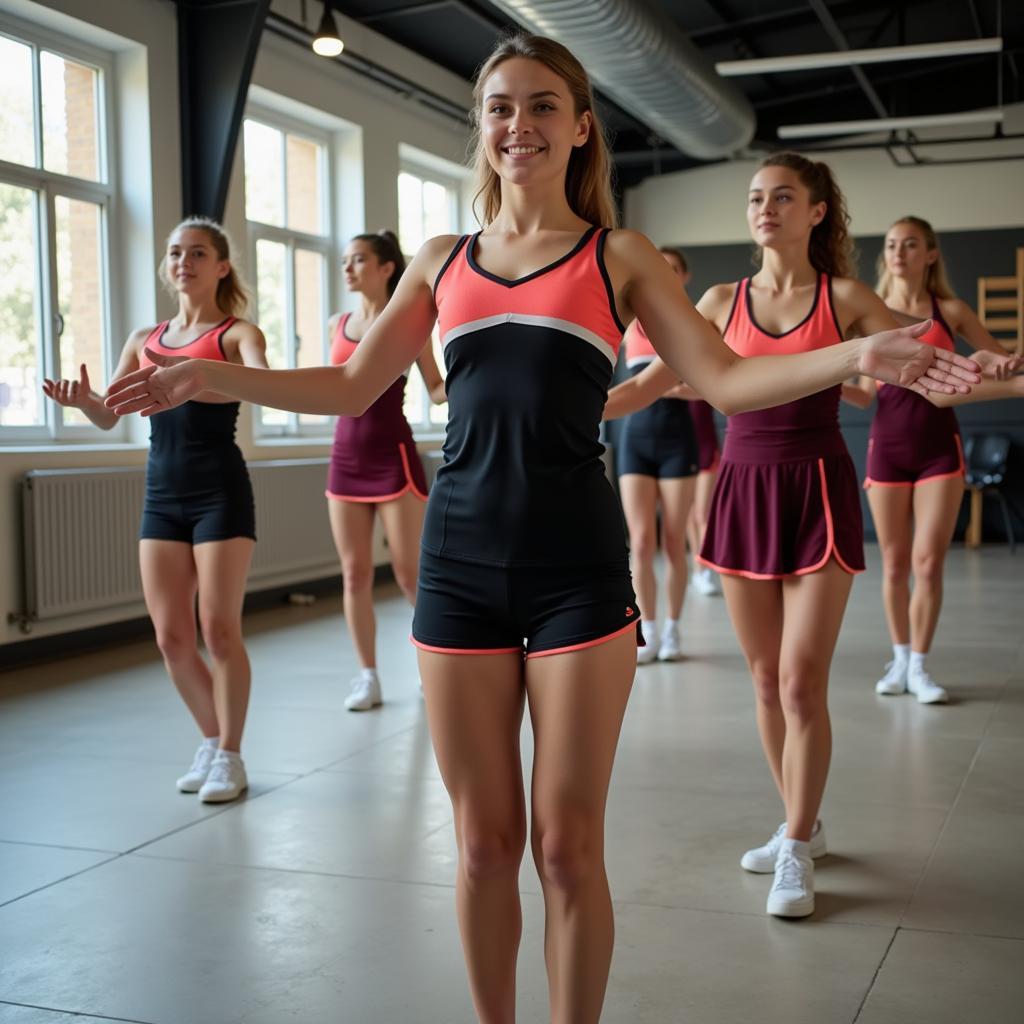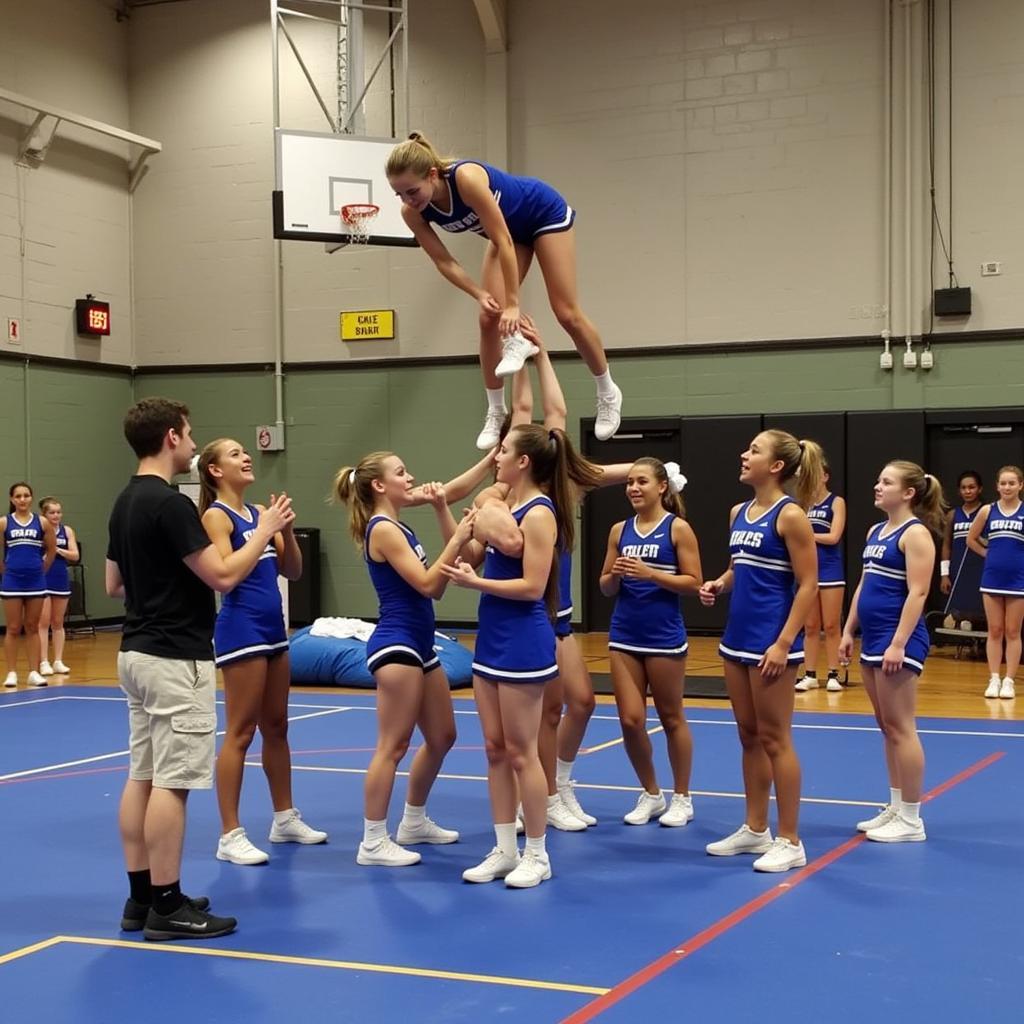Cheerleading is more than just cheering on the sidelines; it’s an athletic discipline that demands dedication, teamwork, and hours of rigorous practice. Whether you’re a seasoned cheerleader or just starting, effective practice sessions are crucial for mastering cheers, perfecting stunts, and building a strong team dynamic.
This comprehensive guide will delve into the essential elements of Cheerleading Practice, equipping you with the knowledge and strategies to maximize your team’s potential. From warm-ups to cool-downs, we’ll cover it all, ensuring you’re well-prepared to bring energy and excitement to every performance.
Setting the Stage for Success: Planning Your Cheerleading Practice
A successful cheerleading practice begins long before the first chant echoes through the gym. Careful planning is essential to ensure your team utilizes its time efficiently and effectively.
1. Define Clear Objectives
Start by outlining the specific goals you want to achieve during each practice session. Are you focusing on perfecting a new routine, improving synchronization, or mastering advanced stunts? Having well-defined objectives provides direction and allows your team to track progress.
2. Structured Practice Plan
A structured practice plan is the roadmap to success. Divide your practice time into dedicated segments for warm-up, skill development, routine practice, and cool-down. Allocate time for each aspect based on your team’s needs and goals.
3. Communication is Key
Effective communication is paramount in cheerleading. Regularly communicate the practice schedule, expectations, and any changes to the team. Encourage open dialogue and feedback to foster a positive and supportive training environment.
Warming Up: Preparing the Body for Action
A proper warm-up routine is non-negotiable for cheerleaders. It prepares muscles for the demands of practice, minimizing the risk of injuries and enhancing performance.
Dynamic Stretching for Flexibility
Dynamic stretching involves controlled movements that mimic cheerleading actions. Incorporate exercises like arm circles, leg swings, and torso twists to improve flexibility and range of motion.
Cardio Blast for Endurance
Cheerleading demands stamina. Integrate 5-10 minutes of cardio exercises like jumping jacks, high knees, or burpees to elevate heart rates and build endurance.
 Cheerleaders Performing Warm-Up Exercises
Cheerleaders Performing Warm-Up Exercises
Skill Development: Honing Essential Cheerleading Techniques
With the warm-up complete, it’s time to focus on skill development. This segment is dedicated to refining fundamental cheerleading techniques and introducing new challenges.
Mastering the Art of Cheers and Chants
Crisp and synchronized cheers are fundamental to cheerleading. Dedicate time to practice cheers and chants, paying close attention to timing, pronunciation, and projection.
Building a Solid Foundation: Jumps and Tumbling
Jumps and tumbling are visually impressive elements of cheerleading. Break down complex jumps into manageable steps, focusing on technique and body control. Gradually introduce tumbling passes as skills progress.
 Cheerleaders Practicing Stunts with Spotters
Cheerleaders Practicing Stunts with Spotters
Strength Training for Stunts
Stunts are an integral part of cheerleading, requiring strength, balance, and trust. Incorporate strength training exercises targeting core muscles, legs, and upper body to enhance stunt performance and stability.
Routine Practice: Putting it All Together
Once individual skills are honed, it’s time to piece them together into a cohesive routine. This stage is about synchronization, transitions, and showmanship.
Choreography and Synchronization
Practice the routine meticulously, ensuring every movement flows seamlessly. Use visual aids like mirrors or video recordings to identify areas for improvement in synchronization and timing.
Performance Quality and Projection
Cheerleading is about captivating the audience. Encourage your team to perform with energy, enthusiasm, and facial expressions that convey the spirit of the routine.
Cool-Down: Rejuvenating the Body
After an intense practice, a proper cool-down is essential for promoting muscle recovery and preventing soreness.
Static Stretching for Flexibility
Incorporate static stretches, holding each pose for 15-30 seconds, to improve flexibility and reduce muscle tension. Focus on major muscle groups used during practice.
Hydration and Recovery
Emphasize the importance of hydration. Encourage your team to drink plenty of water or sports drinks to replenish fluids lost during practice.
Conclusion
Effective cheerleading practices are the cornerstone of a successful and rewarding cheerleading experience. By implementing these strategies and fostering a positive team environment, you’ll empower your cheerleaders to reach their full potential, delivering awe-inspiring performances that leave a lasting impression. Remember, dedication and consistent effort during practice translate to confidence and success on the sidelines or competition floor. Now, go out there, make some noise, and showcase the incredible world of cheerleading!
FAQs
1. How often should cheerleading practice be held?
Ideally, cheerleading practice should be held 2-3 times a week for at least 1-2 hours per session. This frequency allows for adequate skill development and routine practice.
2. What should cheerleaders wear to practice?
Cheerleaders should wear comfortable, athletic clothing that allows for a full range of motion. Avoid loose jewelry or clothing that could pose a safety hazard during stunts or tumbling.
3. How can we make cheerleading practice more fun and engaging?
Incorporate team-building activities, music, and occasional themed practices to keep the energy levels high and foster a positive team spirit.
4. What are some common cheerleading injuries and how can we prevent them?
Common injuries include ankle sprains, wrist fractures, and muscle strains. Proper warm-up, stretching, and safe stunt techniques are crucial for injury prevention.
5. How can we track the progress of our cheerleading team?
Regularly assess individual skills, record practice sessions, and set achievable goals to track the team’s progress. Celebrate accomplishments and identify areas for improvement.
6. What are some tips for creating a supportive and encouraging practice environment?
Encourage open communication, positive reinforcement, and constructive feedback. Foster a team culture where everyone feels valued and respected.
7. How can we prepare our cheerleading team for competitions?
Increase practice frequency and intensity as the competition approaches. Focus on perfecting routines, building stamina, and developing mental toughness.
Need Help with Your Cheerleading Gear?
Check out our amazing selection of blue cheerleading pom poms and gold pom poms cheer to add an extra touch of sparkle to your routines!
For any assistance or inquiries, reach out to our dedicated customer support team:
Phone Number: 0902476650
Email: [email protected]
Address: 139 Đ. Võ Văn Kiệt, Hoà Long, Bà Rịa, Bà Rịa – Vũng Tàu, Việt Nam
We’re here to support your cheerleading journey every step of the way!





